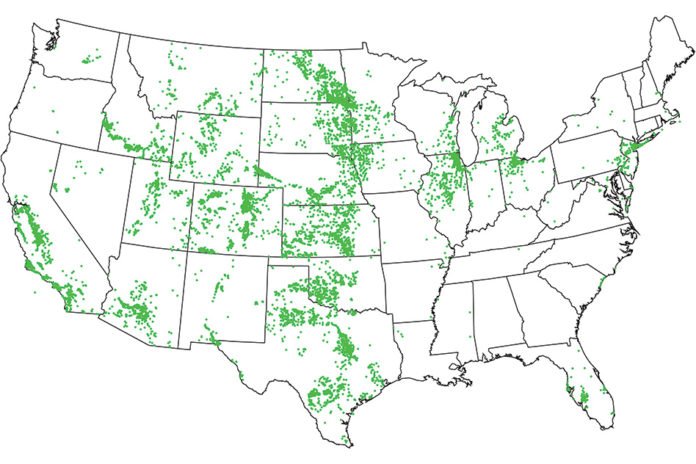The amount of brackish groundwater in the United States is about 800 times greater than the total amount of groundwater withdrawn nationwide for all uses. Until recently, brackish groundwater has been a largely overlooked resource, despite its potential to relieve the mounting pressure on freshwater supplies.
So, using even a fraction of that resource could dramatically improve the prospects for water-starved communities, especially as potable water becomes more scarce, as climate change models predict. While about a fifth of the nation’s water supply comes from fresh groundwater, less than 1 percent currently comes from brackish groundwater.
Now, the latest study by the MIT scientists suggests that there’s a largely untapped resource for many of the increasingly water-limited regions of the U.S. and around the world.
Scientists started this project since they learned about a collection of more than 100,000 groundwater samples from wells at a conference in 2015 by a USGS scientist.
John Lienhard, the Abdul Latif Jameel Professor of Water and Food said, “I was fascinated, and I wondered what we know about how the composition of groundwater affects the desalination process. Discussing this with Yvana Ahdab SM ’17, an MIT graduate student, who quickly found that while seawater composition around the world had been well-studied, scientists discovered that no comparable studies of groundwater had been carried out.”
Lienhard says, “Because of the lower concentration of salt in brackish water, some technologies such as distillation, which can make sense for seawater in some locations, would be very energy-inefficient for desalinating brackish water. Reverse osmosis (RO) or electrodialysis (ED) are the two technologies of choice, and they are the two that are most commonly used.”
“Because seawater is the main feedstock for existing desalination systems, the technology has mostly been developed and optimized for seawater’s composition. Since brackish water is so different. The question we’re interested in is: How much room is there for improvement?”
Ahdab said, “We found that the compositions fall into five classes. Some are dominated by sodium chloride, sodium bicarbonate, or sodium sulfate, while others are dominated by calcium bicarbonate or calcium sulfate. They require very different approaches, in terms of the kind of pretreatment you need. The new analysis, which identifies the specific compositions of the water down to the level of individual wells, will help to guide the development of new systems.”
The outcomes suggest that groundwaters ruled by sodium require considerably more vitality to desalinate than those commanded by calcium, as do those overwhelmed by chloride contrasted with those ruled by sulfate. That data, combined with the maps of brackish water organization the nation over, can help manage plans to grow new water resources.
When correlating the locations with the regions that are experiencing the greatest stresses on their water supplies, results point on specific locations that have the most promising combination of a high need for water and high availability of treatable brackish water, including parts of southern California, Arizona, and areas of the upper Midwest.
Lienhard said, “There’s an enormous amount of brackish groundwater which can be desalinated for fairly low amounts of energy. But more work needs to be done to translate that low need for energy into practical desalination systems that actually have correspondingly low costs.”
While the most total dataset depended on U.S. wells, the group additionally analyzed other, less total arrangements of tests from various different nations, and found that the U.S. drifts in the synthesis and desalination vitality of treatable saline water are probably going to be duplicated in many parts of the world.
Prakash Rao, a researcher at Lawrence Berkeley National Laboratory, who was not involved in this research, says “water shortages in the U.S. are imminent, and the scientific community is needed to address this challenge. Greater utilization of alternate water supplies, like brackish water, to meet growing water demand in the U.S. is likely. But, currently, brackish water is seldom used in the U.S. This creates an urgent need to better understand how best to use our vast brackish water resources. This paper makes an important contribution to this end.”
Rao adds that “Using the approach developed in this paper, water agencies, municipal water authorities, and desalination system designers can make more informed decisions.”
And Rick Stover, director of the International Desalination Association, who also was not involved in this study, says “In my view, the major significance of this work is how comprehensive its geographical reach and its compositional analysis are. It represents a roadmap for brackish desalination, especially in the U.S.”
Stover concludes that “Brackish desalination will likely become a major source of water supply for inland locations around the world. The information presented in this paper provides essential information to guide that development. It’s both significant and timely.”
The coauthors of the study include Yvana Ahdab SM ’17, an MIT graduate student, with John Lienhard, the Abdul Latif Jameel Professor of Water and Food, and three others.
The team included former MIT postdoc Gregory Thiel Ph.D. ’15, and J.K. Böhlke and Jennifer Stanton of the USGS. The work was supported by the National Science Foundation, the U.S. Geological Survey Water Availability and Use Science Program and U.S. Geological Survey National Research Program.
The findings, based on analysis of a massive dataset of water samples from around the country, appears in the journal Water Research.
